| ________________
CM . . . . Volume XVII Number 12. . . .November 19, 2010. 
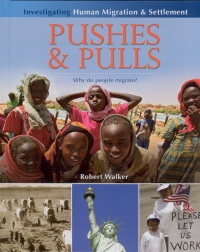 |
Pushes & Pulls: Why Do People Migrate? (Investigating Human Migration and Settlement).
Robert Walker.
St. Catharines, ON: Crabtree, 2010.
48 pp., pbk. & hc., $11.95 (pbk.), $21.56 (RLB.).
ISBN 978-0-7787-5198-4(pbk.), ISBN 978-0-7787-5183-0 (RLB.).
Subject Headings:
Human beings-Migrations-Juvenile literature.
Emigration and immigration-Juvenile literature.
Forced migration-Juvenile literature.
Grades 5-8 / Ages 10-14.
Review by Harriet Zaidman.
****/4
|
| |
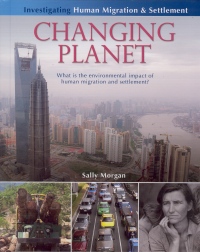 |
Changing Planet: What is the Environmental Impact of Human Migration and Settlement? (Investigating Human Migration and Settlement).
Sally Morgan.
St. Catharines, ON: Crabtree, 2010.
48 pp., pbk. & hc., $11.95 (pbk.), $21.56 (RLB.).
ISBN 978-0-7787-5194-6(pbk.), ISBN 978-0-7787-5179-3 (RLB.).
Subject Headings:
Emigration and immigration-Environmental aspects-Juvenile literature.
Human settlements-Environmental aspects-Juvenile literature.
Cities and towns-Growth-Juvenile literature.
Land use-Environmental aspects-Juvenile literature.
Grades 5-8 / Ages 10-14.
Review by Harriet Zaidman.
****/4
|
| |
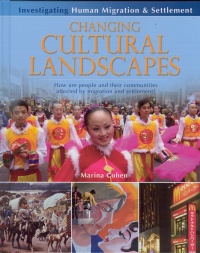 |
Changing Cultural Landscapes: How Are People and their Communities Affected by Migration and Settlement? (Investigating Human Migration and Settlement).
Marina Cohen.
St. Catharines, ON: Crabtree, 2010.
48 pp., pbk. & hc., $11.95 (pbk.), $21.56 (RLB.).
ISBN 978-0-7787-5193-9(pbk.), ISBN 978-0-7787-5178-6 (RLB.).
Subject Headings:
Social change.
Assimilation (Sociology).
Land settlement.
Grades 5-8 / Ages 10-14.
Review by Harriet Zaidman.
****/4
|
| |
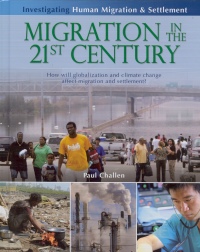 |
Migration in the 21st Century: How Will Globalization and Climate Change Affect Migration and Settlement? (Investigating Human Migration and Settlement).
Paul Challen.
St. Catharines, ON: Crabtree, 2010.
48 pp., pbk. & hc., $11.95 (pbk.), $21.56 (RLB.).
ISBN 978-0-7787-5196-0 (pbk.), ISBN 978-0-7787-5181-6 (RLB.).
Subject Headings:
Emigration and immigration-Forecasting-Juvenile literature.
Emigration and immigration-Economic aspects-Juvenile literature.
Globalization-Juvenile literature.
Grades 5-8 / Ages 10-14.
Review by Harriet Zaidman.
****/4
|
| |
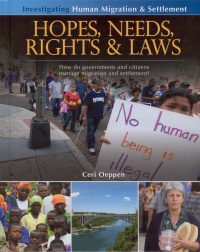 |
Hopes, Needs, Rights & Laws: How Do Governments and Citizens Manage Migration and Settlement? (Investigating Human Migration and Settlement).
Ceri Oeppen.
St. Catharines, ON: Crabtree, 2010.
48 pp., pbk. & hc., $11.95 (pbk.), $21.56 (RLB.).
ISBN 978-0-7787-5195-3 (pbk.), ISBN 978-0-7787-5180-9 (RLB.).
Subject Headings:
Human beings-Migrations-Juvenile literature.
Immigrants-Juvenile literature.
Grades 5-8 / Ages 10-14.
Review by Harriet Zaidman.
****/4
|
| |
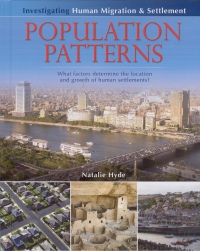 |
Population Patterns: What Factors Determine the Location and Growth of Human Settlements? (Investigating Human Migration and Settlement).
Natalie Hyde.
St. Catharines, ON: Crabtree, 2010.
48 pp., pbk. & hc., $11.95 (pbk.), $21.56 (RLB.).
ISBN 978-0-7787-5197-7(pbk.), ISBN 978-0-7787-5182-3 (RLB.).
Subject Headings:
Population geography-History-Juvenile literature.
Human settlements-Juvenile literature.
Land use-Economic aspects-Juvenile literature.
Cities and towns-Growth-Juvenile literature.
Grades 5-8 / Ages 10-14.
Review by Harriet Zaidman.
****/4
|
| |
|

excerpt:
The United Nations University estimated that by 2008 there were 24 million migrants in the world - including up to 17 million Bangladeshis and four million Filipinos who have moved over the past several decades from low-lying areas for environmental reasons within their countries.
Climate change is expected to change weather patterns and living conditions, and many encourage more migration in the future and lead to the creation of many millions of new "climate migrants." There are two major ways that climate change will increase migration in the years to come: (1) the destruction of people's homes and elimination of jobs due to sudden and severe storms; and (2) the disappearance of land, water, and energy sources and the resulting conflicts arising over competition for these commodities. (From Migration in the 21st Century.)
Understanding the forces that have shaped humanity and those that will form its destiny is an enormous topic. The decisions of European rulers hundreds of years ago to establish colonies afar reverberate in the conflicts today. Industrialization, which has metamorphosed into globalization has led to the plunder of resources and despoiling of landscapes, the rise of the middle classes and enormous swings in financial fortunes, boom and bust cycles coming closer and closer together. Scientists think our wanton activity has led to climate change. The disruption it will wreak has only begun to be felt.
These are but a few of the forces that have caused hundreds of millions of people to migrate around the world over the centuries, escaping discrimination, war, or seeking a better life. These migrations have displaced indigenous populations and led to the rise of new societies, some of which have been stable over time but are eventually changed by newer migrations. Each time a new group of people migrated, an impact occurred in the economy, the culture and the makeup of society.
"Investigating Human Migration and Settlement" is a collection of six books that does an excellent job of discussing important themes related to human migration and settlement through time and around the globe. They are written at a Grade 6 level but will be appealing and useful to students up to Grade 8. Refreshingly, these books do nothing to simplify the issues - they provide historical background and a reporting of contemporary events while applying this information to posit what will happen in the future. The authors are experienced researchers, scholars and writers with expertise in social issues and writing for young adults.
Each title is 48 pages long, with six chapters followed by a glossary, "Ideas for Discussion" and "Further Information" (suggested websites) and a detailed index. The chapters progress from a general introduction of the issue to the more specific aspects. For example, in Pushes & Pulls - Why Do People Migrate?, the first chapter defines the term 'migration' and explains why people might either be pushed into leaving their homes for the unknown, as were the Irish in the Great Famine of the 19th century, or pulled by incentive or affluence, citing both the dream of riches dangled by the New World in the Age of Exploration and the comfort of a warm climate that has made Florida a draw for seniors today. In the subsequent chapters, author Robert Walker traces the history of pushes and pulls, writing about Expansion & Colonialism and Forced Transportation, and then he shows how modern events have forced people to move in chapters called Political and Social and Religious Migration (covering the wake of 9/11 and the invasion of Afghanistan), Environmental Disasters and The Push & Pull of Economics.
The continent of Africa has a long, devastating history of drought. Africa has experienced at least one major drought each decade for the last 30 years. Much of Africa's agriculture is rain fed, so when drought occurs in one region, people are forced to adapt by migrating.
As the first decade of the 2000s draws to a close, millions of Africans are threatened by drought and famine. Farmers and herders have been forced to abandon their crops and livestock in search of food and water. Refugee camps are overwhelmed with people in need.
In Ethiopia, as may as 14 million people are having trouble finding enough food to eat - and that number is expected to rise.
Reports of fighting over water and pastureland are on the rise in northeastern Kenya. A lack of water has resulted in many people migrating from rural areas into the eastern towns of Ujara and Wajir. Other areas in Kenya, such as Marsabit, are also taking in huge numbers of internally displaced people.
In Somalia, hundreds of thousand of people have been affected by the drought. Huge numbers from rural areas are migrating to Somalia's urban centres.
The impact of migration has changed the world. Immigrants have often been made the brunt of blame for society's problems and subjected to racist attacks. The difficulties immigrants face as they adjust to their new situations are enormous as they grapple with what will happen to their cultural identity if they integrate and assimilate. The contradictory problem is expressed well in Changing Cultural Landscapes:
The bond that first-generation immigrants have with their culture can be a source of strength and comfort as they adjust to their new surroundings. For their children, however, those cultural ties may be an obstacle to their need to become a part of the prevailing cultural landscape.
...Sometimes the opposite occurs. In certain circumstances, parents have assimilated into the mainstream culture, downplayed their own cultures to avoid "trouble" or embarrassment for themselves or their families, or even embraced the mainstream culture with open arms...in some instances, the second-generation children of such parents may seek out on their own a strong return to their cultural roots. In some cases, they may even return to their parents' country of origin to visit or settle.
The books are illustrated with maps, historical representations and photographs of people in the many places they are found, from crowded refugee camps and shanty towns to look-a-like suburbs and the emptiness of the Arctic. The captions are informative and complement the text on each page. Sidebars with examples from different parts of the world enhance the chapter topics and diary entries of migrants at various times in history add further dimension to the information.
Social studies teachers will find this series extremely useful in presenting a unit on human migration, world issues, rights, responsibility, the environment and cultures. It will be a welcome, reliable, up-to-date addition to a classroom or library collection.
Highly Recommended.
Harriet Zaidman is a teacher-librarian in Winnipeg, MB.

To comment on this title or this review, send mail to
cm@umanitoba.ca.
Copyright © the Manitoba Library Association. Reproduction for personal use is permitted only if this copyright notice is maintained. Any other reproduction is prohibited without permission.
NEXT REVIEW |
TABLE OF CONTENTS FOR THIS ISSUE- November 19, 2010.
AUTHORS |
TITLES |
MEDIA REVIEWS |
PROFILES |
BACK ISSUES |
SEARCH |
CMARCHIVE |
HOME |





